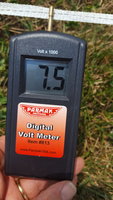Sunshine Flock
Crowing
I'm trying to better understand a few things with electric fencing for bears.
1) Most folks seem to recommend 14 gauge galvanized steel wire. It's really hard to work with, but it won't easily bend or stretch like aluminum, which is what you want with big predators. The wire needs room for movement, so that's why you use pass-through insulators everywhere but on the ends. With such heavy wire, though, this makes for some pretty baggy lines.
Where the ends are secured, I'm using large screw-in hooks. They're prone to breaking. How do you tighten down the wire enough so it's not baggy?
2) How many inches out from the fencing do you run your hot wire? And what's your preference for insulators to accommodate corner posts? With hot wire that's not very tidy/taut, it needs more space or it could easily end up touching the fencing. I'm swapping out wood post insulators that sit flat against them for longer ones that hold the wire a couple inches out from the fencing. But the screw-in hooks to secure the ends are closer to the post. This creates an angle as the wire approaches the hooks. I need to find hooks that sit out further from the mount.
3) Gates: How are you wiring them? I'm seeing different methods. Are you using one handle and connecting the rows of hot wire on the gate with insulated wire?
4) We're in a hot climate most of the year with dry ground. But I have yet to find someone who's running a hot-cold wiring system. They're all relying on grounding rods. The thing with the hot-cold system is that the bear needs to touch both a hot and cold wire simultaneously to complete the circuit for it to work. I was thinking I'll try three rods and run all hot wire for the winter and spring, see how it goes and test daily with a voltmeter, and during summer keep a bucket of water near the grounds with a pinprick hole on the bottom. But I don't want to be dependent on that bucket, so the other method seems like a good option.
5) I'm also noticing that most people are running three strands of hot wire and nothing more. I suppose as long as the hot wire is run along fencing, the bear can't climb through and is more likely to touch the wire. But if you're going to bother with the initial investment, it doesn't cost much more to run more wire. Some experts say five hot strands at a minimum, 8" to 10" apart.
I'd love to know your thoughts on all of this. Thank you.
1) Most folks seem to recommend 14 gauge galvanized steel wire. It's really hard to work with, but it won't easily bend or stretch like aluminum, which is what you want with big predators. The wire needs room for movement, so that's why you use pass-through insulators everywhere but on the ends. With such heavy wire, though, this makes for some pretty baggy lines.
Where the ends are secured, I'm using large screw-in hooks. They're prone to breaking. How do you tighten down the wire enough so it's not baggy?
2) How many inches out from the fencing do you run your hot wire? And what's your preference for insulators to accommodate corner posts? With hot wire that's not very tidy/taut, it needs more space or it could easily end up touching the fencing. I'm swapping out wood post insulators that sit flat against them for longer ones that hold the wire a couple inches out from the fencing. But the screw-in hooks to secure the ends are closer to the post. This creates an angle as the wire approaches the hooks. I need to find hooks that sit out further from the mount.
3) Gates: How are you wiring them? I'm seeing different methods. Are you using one handle and connecting the rows of hot wire on the gate with insulated wire?
4) We're in a hot climate most of the year with dry ground. But I have yet to find someone who's running a hot-cold wiring system. They're all relying on grounding rods. The thing with the hot-cold system is that the bear needs to touch both a hot and cold wire simultaneously to complete the circuit for it to work. I was thinking I'll try three rods and run all hot wire for the winter and spring, see how it goes and test daily with a voltmeter, and during summer keep a bucket of water near the grounds with a pinprick hole on the bottom. But I don't want to be dependent on that bucket, so the other method seems like a good option.
5) I'm also noticing that most people are running three strands of hot wire and nothing more. I suppose as long as the hot wire is run along fencing, the bear can't climb through and is more likely to touch the wire. But if you're going to bother with the initial investment, it doesn't cost much more to run more wire. Some experts say five hot strands at a minimum, 8" to 10" apart.
I'd love to know your thoughts on all of this. Thank you.
Last edited:






